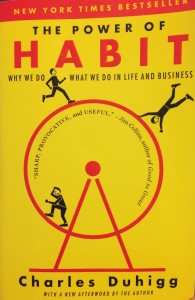 One story in The Power of Habit: Why We Do What We Do in Life and Business, by Charles Duhigg, opened my eyes to how much of my work over the past 15 years has been trying to break a habit loop.That is the story of former Alcoa CEO, Paul O’Neill, who improved the entire company focusing only on the keystone habit of safe work practices. I’ve been doing something similar in my job without understanding the science behind it.
One story in The Power of Habit: Why We Do What We Do in Life and Business, by Charles Duhigg, opened my eyes to how much of my work over the past 15 years has been trying to break a habit loop.That is the story of former Alcoa CEO, Paul O’Neill, who improved the entire company focusing only on the keystone habit of safe work practices. I’ve been doing something similar in my job without understanding the science behind it.
The Power of Habit is bestseller is about how our lives, work, and social patterns are driven by habits. Duhigg describes how we can change bad habits and use good ones to our advantage. There is a lot of value in this book, both professionally and personally.
I’ve spent a lot of time working to improve the environmental condition of facilities. It can progress from cleaning up a bad situation, then becoming compliant with environmental and safety regulations, and then turning it into an everyday part of a job that becomes is easy, enjoyable and constantly improving. It applies perfectly to the concept of the habit loop that Duhigg presents in the book.
Simplified, the habit loop begins with a cue, which is then acted out with a routine, in order to get a reward. To change a habit, the cue and reward stay the same, but the routine needs to be replaced with something different. My attempts to break bad, or nonexistent, habits involve the following.
1) Don’t make it about the environment or a regulation. Make it about their health. In this instance, changing the routine is done by changing a way of thinking. People don’t want to change their work routines because of a regulation written by a legal team 30 years ago. That doesn’t connect. Many people also don’t care to change a routine because of an “environmental issue that doesn’t concern me”.
What does connect is understanding that your actions can contaminated the lake where you like to fish and swim. What also connects is understanding the toxic consequences of poor hazard management. When they hear an amusing or horror story about someone similar being exposed to a toxic chemical, they relate and are now open a change. The NIMBY connection goes a long way. This one is also similar to the power of societal connections on changing habits that Duhigg describes.
2) The second one is more practical. It is simply to provide a tool or methodology to make a task easier. In a bad facility, typically they either don’t know about or haven’t implemented an existing methodology to improve their environment. They have a cue, such as getting rid of hazardous waste. They want the reward of it going out of sight as easy as possible. Therefore we need to change the routine by making it easier. This can be as simple as a new drum, funnel, pump, or collection system.
You can’t identify a problem and then not offer a solution. If you help them fix the problem while also making their workplace cleaner and safer, it makes it easier to break the habit loop. The introduction of one new tool or methodology that makes their facility cleaner and easier often leads to further improvements taken on by the facility themselves.
